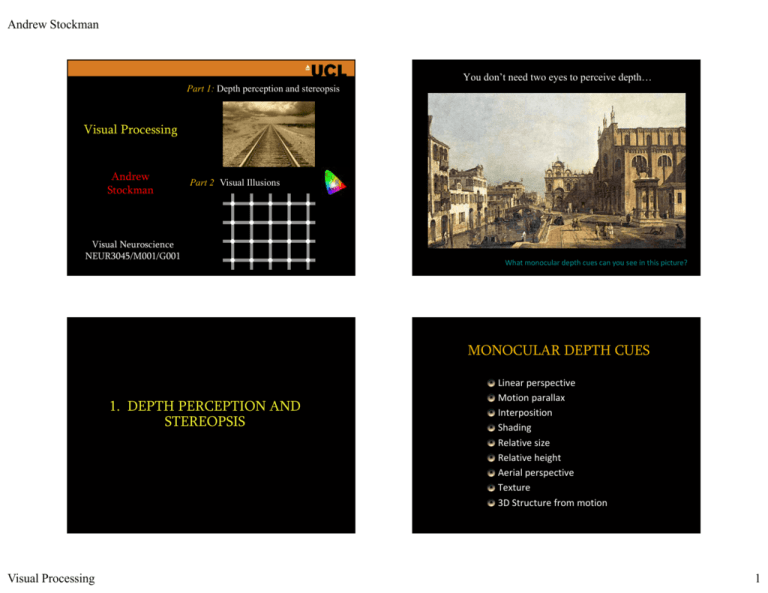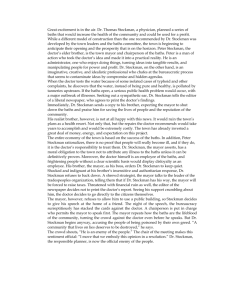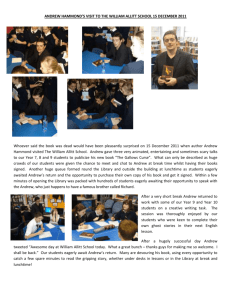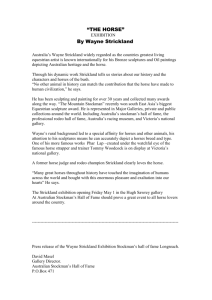1. DEPTH PERCEPTION AND STEREOPSIS MONOCULAR DEPTH
advertisement

Andrew Stockman You don’t need two eyes to perceive depth… Part 1: Depth perception and stereopsis Visual Processing Andrew Stockman Part 2: Visual Illusions Visual Neuroscience NEUR3045/M001/G001 What monocular depth cues can you see in this picture? MONOCULAR DEPTH CUES 1. DEPTH PERCEPTION AND STEREOPSIS Visual Processing Linear perspective Motion parallax Interposition Shading Relative size Relative height Aerial perspective Texture 3D Structure from motion 1 Andrew Stockman Linear perspective Motion parallax Motion parallax Interposition Fixation point determines plane in the scene that doesn’t move. Credit: John Krantz Visual Processing Credit: John Krantz 2 Andrew Stockman Depth from shading Shading What assumption about the light source is being made? Relative size Inverted face illusion Visual Processing Credit: John Krantz 3 Andrew Stockman Relative size Aerial perspective Credit: John Krantz Aerial perspective Relative height Credit: John Krantz Visual Processing 4 Andrew Stockman 3D structure from motion Texture Myron L. Braunstein What cues are in this picture? Linear perspective Motion parallax X Interposition Shading Relative size Relative height Aerial perspective Texture 3D Structure from motion X Texture Visual Processing 5 Andrew Stockman Convergence Accommodation Angle of convergence Angle of convergence Credit: Lindsay and Norman Crossed disparity Binocular disparity STEREO DEPTH CUES Convergence Binocular disparity Visual Processing A and B are at the same depth and thus have the same disparity (of zero since it is A that is fixated) 6 Andrew Stockman Binocular disparity Farther (uncrossed) (A) Uncrossed disparity (B) Crossed disparity Nearer (crossed) You get diplopia (double vision) outside Panums’s fusional area. Credit: Webvision Uncrossed disparity: An object farther away than the horopter has uncrossed disparities. You must 'uncross' your eyes to fixate on it. Farther (uncrossed) Nearer (crossed) Crossed disparity: An object closer than the horopter has crossed disparity. You must 'cross' your eyes to fixate on it. Visual Processing 7 Andrew Stockman Cortical projections Principal of stereograms Credit: Braddick Dave Pape, Wikipedia Visual Processing 8 Andrew Stockman Visual Processing 9 Andrew Stockman Autostereograms 'Furrows' (1979). One of the first random-dot autostereograms (from Tyler, 1994). Converge or diverge the eyes so as to see a triplet of three red dots Visual Processing 10 Andrew Stockman DEPTH CUES: Summary Monocular Linear perspective Motion parallax Interposition Shading Relative size Relative height Aerial perspective Texture 3D Structure from motion Accommodation Binocular Convergence Binocular disparity Why study illusions? Seeing is not always believing Failures can provide an insight into how the visual system works They are fun Usually “perception” rather than “sensation” Try to come up with your own explanations as we go through them… Illusions of colour and luminance We’ve already encountered many illusions in the colour and luminance (and other) lectures. 2. VISUAL ILLUSIONS Even something as simple as a mixture of red and green spectral lights appearing identical to a yellow spectral light might be considered to be an illusion. However, once the biological basis of an effect becomes well understood, less likely to be thought of as an illusion. Visual Processing 11 Andrew Stockman Benham’s Top ILLUSIONS OF COLOUR Chromostereopsis Color contrast Examples of colour illusions Visual Processing Different colours are perceived at different depths… Akitaoka Kitaoka 12 Andrew Stockman Linked to lateral achromatic aberrations… ILLUSIONS OF BRIGHTNESS Nuke tutorials Chromostereoscopic windows BRIGHTNESS CONTRAST EFFECTS The brightness of a patch depends on the brightnesses of things that surround it… You’ve seen examples of these in other lectures… Akitaoka Kitaoka Visual Processing 13 Andrew Stockman Simultaneous brightness contrast White illusion Dungeon illusion BRIGHTNESS ASSIMILATION The brightness of a small patch depends on the brightnesses of things that immediately surround it… Pereverzeva M , Murray S O J Vis 2009;9:19 Visual Processing 14 Andrew Stockman Craik-O’Brien-Cornsweet Illusion (2) BRIGHTNESS EDGE EFFECTS The edge between two patches affects their relative brightnesses… Michael Bach Craik-O’Brien-Cornsweet illusion Mach bands Credit: Thomas Wachtler and Christian Wehrhahn Visual Processing 15 Andrew Stockman Mach bands Mach band steps Mach band steps BRIGHTNESS CONSTANCY Visual Processing 16 Andrew Stockman Adelson Brightness constancy Adelson Craik-O’Brien-Cornsweet Illusion (3) Brightness constancy Adelson Visual Processing 17 Andrew Stockman Motion Induced Blindness ILLUSIONS OF MOTION http://michaelbach.de/ot/index.html Silencing by Motion http://michaelbach.de/ot/index.html Visual Processing Michael Bach Flash-Lag Effect Michael Bach after Suchow & Alvarez http://michaelbach.de/ot/index.html Michael Bach after R. Nijhawan 18 Andrew Stockman Spiral after effect “Stepping feet” illusion After Stuart Anstis, drawn by Michael Bach Michael Bach Spiral after effect Motion binding illusion Michael Bach Visual Processing Michael Bach 19 Andrew Stockman Sigma Motion ILLUSIONS OF DEPTH The grating is simply contrast reversing. Move your finger along it from left to right with a speed such that you travel the distance in about 2 seconds, while following the finger with your gaze. At the right speed, you should perceive a smooth rightwards motion of the stripes. Now move your finger back. If you follow it again with your eyes, you will see smooth leftwards motion of the stripes. Michael Bach Motion-Bounce illusion Michael Bach Visual Processing 20 Andrew Stockman Shepard’s Table illusion Corridor Version by Akiyoshi Kitaoka Size distortion Shepard’s “Turning the Tables” illusion http://michaelbach.de/ot/index.html Visual Processing Michael Bach 21 Andrew Stockman Ames Window Ames Room Video: Richard Gregory Trapezoidal window was designed by Adelbert Ames. The window is not rectangular, but trapezoidal. Because of your experience with rectangular windows and the specific shape of the trapezoidal window, you see this window oscillating from right to left and back again, even though it is actually rotating in a complete circle. Ames Room (2) Trapezoidal Windows Credits: Janet D. Larsen Visual Processing 22 Andrew Stockman Impossible staircase Impossible waterfall These figures can only exist in 2D Credit: Sandlot Science Escher and Cordon Art B.V. Impossible triangle GEOMETRICAL ILLUSIONS Visual Processing 23 Andrew Stockman Müller-Lyer explanation Müller-Lyer Credit: Richard Gregory “Carpentered world" hypothesis Müller-Lyer Visual Processing Ponzo 24 Andrew Stockman Ponzo scene Poggendorf Visual Processing Poggendorf Poggendorf 25 Andrew Stockman “Runways” Poggendorf Credit: Akiyoshi Kitaoka “Runways” Zöllner Credit: Akiyoshi Kitaoka Visual Processing WyrmCorp 26 Andrew Stockman Hering Zöllner (2) Credit: Michael Bach Hering Hering Credit: Michael Bach Visual Processing 27 Andrew Stockman Hering / Zöllner Ebbinghaus Relatively Interesting,com Credit: Michael Bach Ehrenstein Typical explanations Impressions of depth: the shorter lines are at an angle to the longer lines. This angle helps to create the impression that one end of the longer lines is nearer to us than the other end. Apparent changes in angle: the brain increases the angle between the long line and the shorter lines that cross it. As a result, the brain bends the longer lines towards or away from each other Visual Processing 28 Andrew Stockman Café-wall illusion Coal mine Credit: Akiyoshi Kitaoka "Communication among eggs" Frazer spiral Credit: Akiyoshi Kitaoka Visual Processing 29 Andrew Stockman Midorigame (Green turtle) Frazer spiral in motion Akiyoshi Kitaoka Men with sunglasses An explanation? Akiyoshi Kitaoka Akiyoshi Kitaoka Visual Processing 30 Andrew Stockman An explanation? Illusory squares Akiyoshi Kitaoka Illusory triangle ILLUSORY FIGURES Visual Processing 31 Andrew Stockman Illusory circles Necker cube Necker cube (2) AMBIGUOUS FIGURES Visual Processing Is the green dot in the lower left rear corner or in the lower left front corner? 32 Andrew Stockman Missing corner illusion Two women? Spinning Dancer Skull? Visual Processing 33 Andrew Stockman Rabbit duck Vase Eskimo Father son Visual Processing 34 Andrew Stockman UNSTABLE FIGURES János Geier Scintillating grid illusion Hermann’s grid Lingelbach (1994) Visual Processing 35 Andrew Stockman Rotating spiral snakes János Geier Credit: A. Kitaoka “The Enigma” Isia Leviant (1981), Palais de la Découverte, Paris Visual Processing 36 Andrew Stockman Thatcher illusion (1) Credit: Peter Thompson Thatcher illusion (2) Credit: Peter Thompson Visual Processing 37







